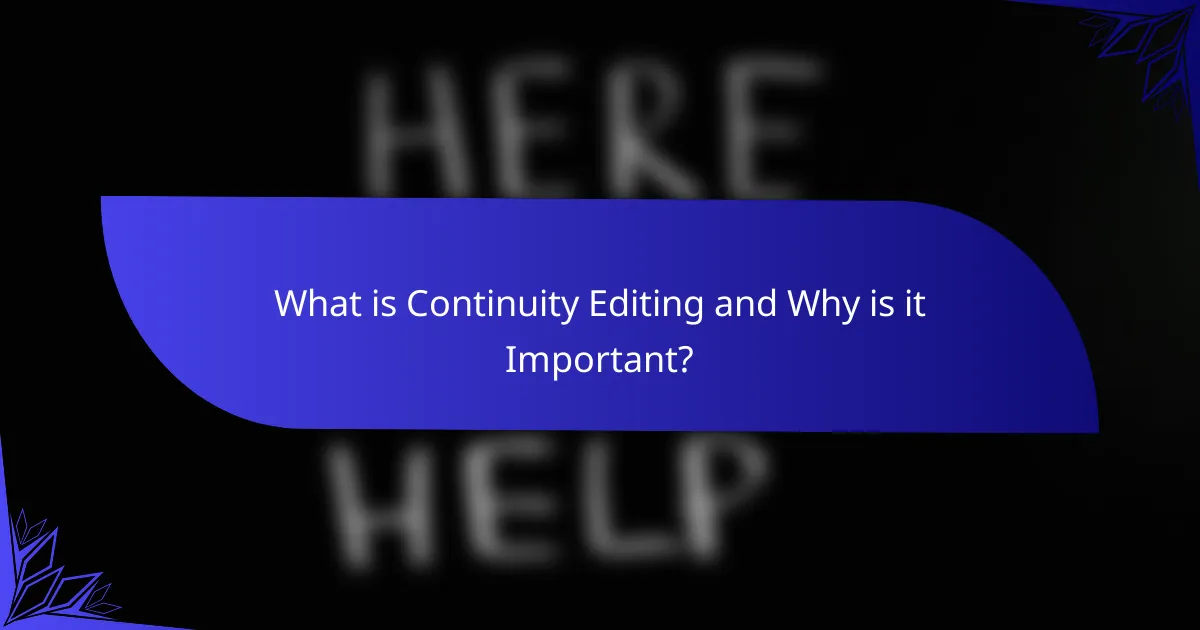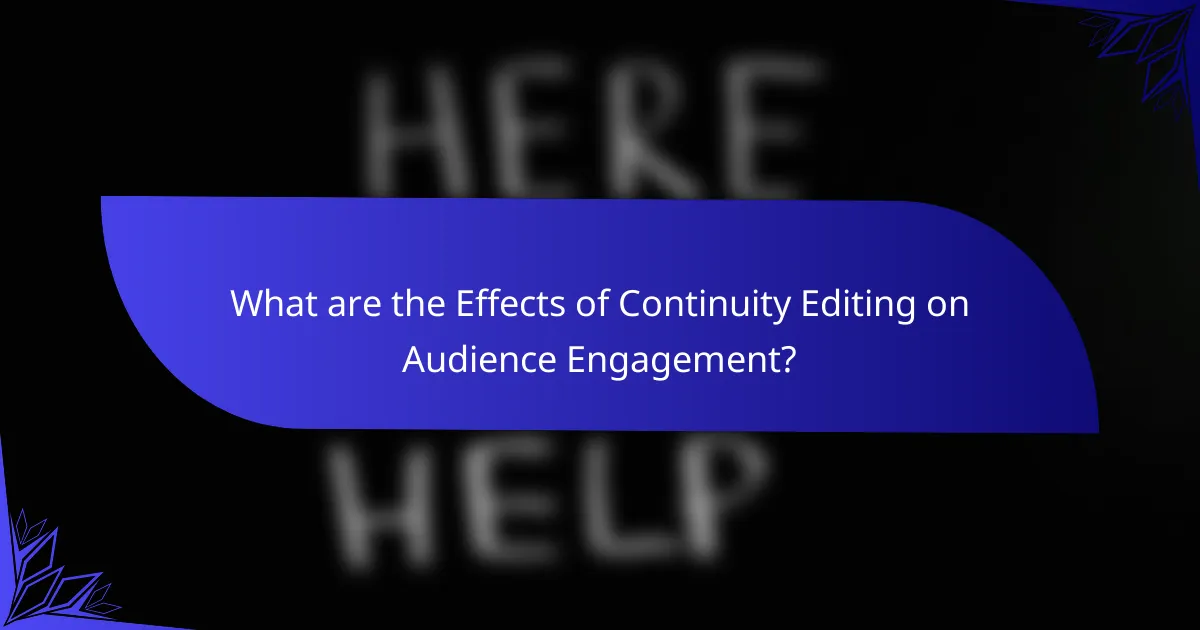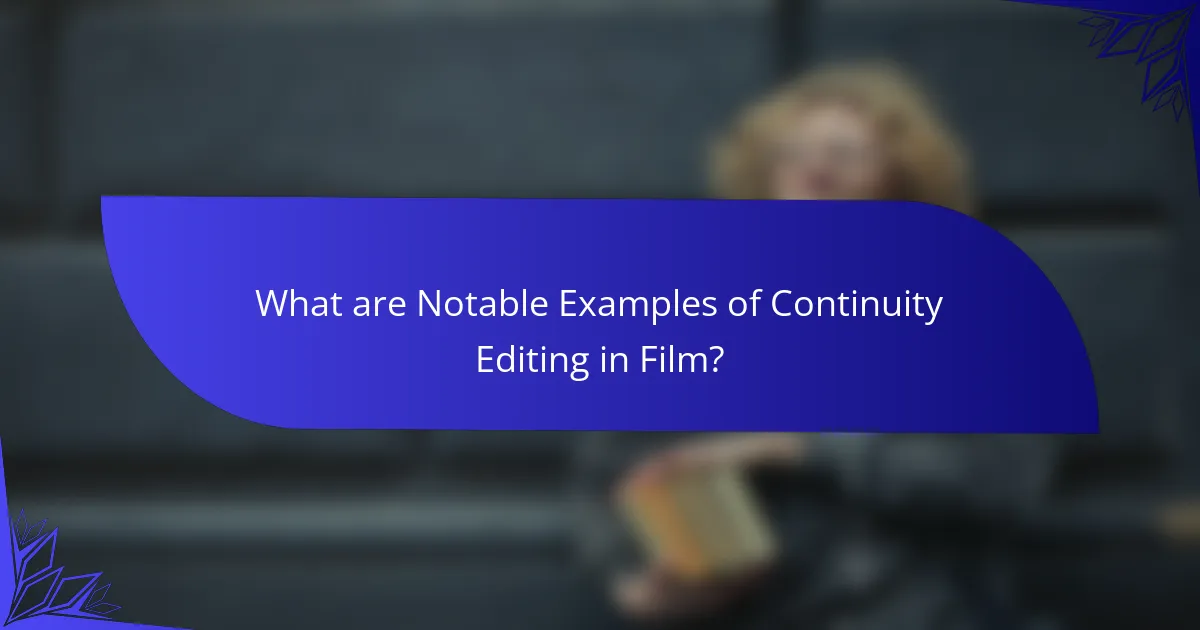Continuity editing is a vital filmmaking technique that ensures a seamless flow of action and narrative, maintaining spatial and temporal consistency. This article explores the principles of continuity editing, highlighting its role in enhancing audience engagement and understanding. It discusses various methods, such as match cuts and shot-reverse-shot, and presents notable examples from films like “The Godfather,” “Psycho,” and “Birdman,” illustrating how effective continuity editing fosters viewer retention and emotional involvement. By providing clarity in storytelling, continuity editing allows audiences to immerse themselves in the narrative without distractions.

What is Continuity Editing and Why is it Important?
Continuity editing is a filmmaking technique that ensures a seamless flow of action and narrative. It maintains spatial and temporal consistency, allowing viewers to follow the story without confusion. This technique uses various methods, such as match cuts and shot-reverse-shot, to create a coherent visual experience. Its importance lies in enhancing audience engagement by making the narrative easier to understand. Studies show that effective continuity editing can significantly improve viewer retention and emotional involvement. By providing clarity, it allows the audience to immerse themselves in the story without distractions.
How does Continuity Editing contribute to storytelling in film?
Continuity editing enhances storytelling in film by ensuring a seamless narrative flow. It maintains spatial and temporal consistency across scenes. This technique allows viewers to follow the story without confusion. For example, matching the eyelines of characters creates a sense of realism. Additionally, maintaining consistent lighting and sound helps to immerse the audience. Studies show that effective continuity editing increases viewer engagement and emotional investment. The classic film “Casablanca” exemplifies these principles through its smooth transitions and coherent storyline. Overall, continuity editing is vital for coherent storytelling in cinema.
What are the key principles that define Continuity Editing?
Continuity editing is defined by principles that ensure a seamless flow of narrative in film. The first principle is the 180-degree rule, which maintains spatial relationships between characters. This rule helps audiences understand the geography of a scene. The second principle is shot/reverse shot, commonly used in dialogue scenes. This technique alternates between characters, enhancing their interactions. The third principle is match on action, which creates a smooth transition between shots. This technique connects actions across cuts, maintaining continuity. These principles collectively enhance viewer comprehension and engagement. They guide filmmakers in creating coherent storytelling.
How does Continuity Editing enhance narrative flow?
Continuity editing enhances narrative flow by creating a seamless visual experience for the audience. It maintains spatial and temporal coherence in storytelling. This technique uses techniques such as match on action, eye-line match, and shot/reverse shot. These methods ensure that cuts do not disrupt the viewer’s understanding of the scene. For example, when a character moves from one location to another, continuity editing shows the action fluidly. This keeps the audience engaged and focused on the story. Studies show that effective continuity editing can increase audience retention and emotional investment. By minimizing distractions, it allows viewers to immerse themselves in the narrative.
What are the common techniques used in Continuity Editing?
Common techniques used in continuity editing include the 180-degree rule, match on action, and shot/reverse shot. The 180-degree rule maintains spatial consistency by keeping the camera on one side of an imaginary line. This technique helps the audience understand the spatial relationship between characters. Match on action involves cutting from one shot to another view that matches the action in the first shot. This technique creates a seamless flow in the narrative. Shot/reverse shot is often used in conversations, showing one character speaking and then cutting to the other character’s response. These techniques enhance narrative coherence and viewer engagement.
How do match cuts function within Continuity Editing?
Match cuts function within continuity editing by creating a seamless transition between two different shots that share similar visual elements. This technique enhances narrative flow and maintains spatial and temporal coherence. For example, a match cut can link a character’s action in one scene to a similar action in another scene. This connection helps the audience perceive a continuous story without jarring interruptions. The visual similarity ensures that the viewer’s attention is directed smoothly from one moment to the next. By maintaining visual consistency, match cuts reinforce the story’s rhythm and pacing. This technique is widely used in film, as seen in classic examples like Stanley Kubrick’s “2001: A Space Odyssey.” The effectiveness of match cuts in continuity editing lies in their ability to engage the audience while preserving the narrative’s integrity.
What role does shot/reverse shot play in maintaining continuity?
Shot/reverse shot is a technique that plays a crucial role in maintaining continuity in film editing. This method involves alternating between shots of two characters in conversation. It creates a spatial relationship between the characters, allowing the audience to understand their interactions better. By consistently framing the characters in a specific way, shot/reverse shot helps to establish a clear line of sight. This technique enhances the illusion of continuous time and space, making the scene more coherent. Research in film theory supports this, indicating that shot/reverse shot effectively guides viewer attention and fosters emotional engagement. Therefore, shot/reverse shot is essential for ensuring that scenes flow logically and maintain narrative clarity.

What are the Effects of Continuity Editing on Audience Engagement?
Continuity editing enhances audience engagement by creating a seamless narrative flow. This technique allows viewers to easily follow the story without confusion. It maintains spatial and temporal coherence, which helps in maintaining immersion. Research indicates that effective continuity editing increases viewer retention and emotional involvement. For instance, a study by Bordwell and Thompson (2010) demonstrates that viewers prefer films with clear continuity over disjointed editing styles. This preference leads to a more enjoyable viewing experience, fostering deeper connections with characters and plot. Thus, continuity editing serves as a crucial tool for filmmakers to engage their audience effectively.
How does Continuity Editing influence viewer perception?
Continuity editing influences viewer perception by creating a seamless narrative flow. This technique helps maintain spatial and temporal coherence in a film. Viewers can easily follow the story without confusion. It encourages emotional engagement by allowing audiences to immerse themselves in the narrative. Studies show that effective continuity editing enhances comprehension and retention of the plot. For instance, research by Bordwell and Thompson highlights how consistent visual cues guide viewer attention. This leads to a more satisfying viewing experience. Ultimately, continuity editing shapes how viewers interpret and connect with the story being told.
What psychological effects does seamless editing have on audiences?
Seamless editing creates a sense of immersion for audiences. This technique minimizes distractions and maintains narrative flow. Audiences experience heightened emotional engagement with the story. They are less likely to notice cuts or transitions. Research indicates that seamless editing can enhance viewer empathy. A study by Zacks et al. (2001) found that continuity editing affects how viewers perceive time and space in narratives. This results in a more cohesive understanding of the story. Furthermore, seamless editing can lead to increased suspense and tension. This keeps audiences invested in the unfolding events. Overall, seamless editing profoundly influences audience perception and emotional response.
How does Continuity Editing create emotional connections with characters?
Continuity editing creates emotional connections with characters by maintaining a seamless flow of action and narrative. This technique allows viewers to follow the story without confusion. It uses consistent visual and auditory cues to build familiarity with characters. By showing reactions and interactions in a logical sequence, viewers can empathize with characters’ experiences. The use of shot-reverse-shot techniques enhances dialogue scenes, making emotional exchanges more impactful. Additionally, continuity editing aligns character focus with audience attention, drawing viewers into their emotional journeys. This method effectively fosters a deeper investment in character arcs, enhancing overall audience engagement.
In what ways does Continuity Editing impact the pacing of a film?
Continuity editing impacts the pacing of a film by creating a smooth flow of action and maintaining spatial and temporal coherence. This technique helps audiences follow the narrative without confusion. By using consistent shot sizes and angles, continuity editing allows for a seamless transition between scenes. This reduces the cognitive load on viewers, enabling them to engage more deeply with the story. Additionally, continuity editing can manipulate the rhythm of a scene. Quick cuts can accelerate pacing, while longer takes can slow it down. Studies show that films employing effective continuity editing often enhance viewer immersion and emotional response. For example, films like “The Godfather” utilize continuity editing to maintain narrative clarity while controlling pacing.
How does pacing affect audience attention and engagement?
Pacing significantly influences audience attention and engagement. Proper pacing maintains viewer interest by balancing action and dialogue. Fast pacing can create excitement and urgency. Slow pacing allows for emotional depth and reflection. Research indicates that variations in pacing can enhance narrative tension. For instance, a study by Zacks et al. (2001) found that well-timed pacing improves comprehension and retention. This demonstrates that effective pacing strategies are crucial for maximizing audience engagement.
What are the consequences of poor Continuity Editing on viewer experience?
Poor continuity editing disrupts viewer experience by creating confusion. Inconsistent visual details can lead to viewer distraction. This distraction reduces immersion in the narrative. Viewers may struggle to follow the story due to jarring cuts. For example, a character’s clothing changing between shots can break the illusion. Such inconsistencies can lead to frustration. Frustrated viewers are less likely to engage with the content. Research shows that seamless editing enhances narrative comprehension. Effective continuity editing maintains the audience’s focus on the story.

What are Notable Examples of Continuity Editing in Film?
Notable examples of continuity editing in film include “The Godfather,” “Psycho,” and “Birdman.” In “The Godfather,” seamless transitions maintain narrative flow and character focus. “Psycho” uses continuity editing to heighten suspense during the infamous shower scene. “Birdman” employs long takes and fluid transitions to create the illusion of a single continuous shot. These films effectively demonstrate how continuity editing enhances storytelling by maintaining spatial and temporal coherence.
Which films exemplify the principles of Continuity Editing effectively?
“Casablanca” exemplifies the principles of Continuity Editing effectively. The film maintains spatial and temporal coherence throughout its narrative. It employs techniques such as match cuts and shot-reverse-shot sequences. “Casablanca” ensures that the audience remains engaged without confusion. Another notable example is “The Godfather,” which uses continuity editing to enhance storytelling. The film’s seamless transitions support character development and plot progression. “The Godfather” also showcases the effectiveness of eyeline matches. Both films are celebrated for their mastery of continuity editing techniques.
How does “The Godfather” utilize Continuity Editing to enhance storytelling?
“The Godfather” utilizes continuity editing to create a seamless narrative flow. This technique allows for a coherent visual experience. It maintains spatial and temporal consistency across scenes. For example, the use of match cuts connects actions and dialogue effectively. This enhances the emotional impact of key moments. The film’s editing also supports character development by linking their actions across various settings. These choices keep the audience engaged and immersed in the story. Overall, continuity editing in “The Godfather” strengthens storytelling by ensuring clarity and emotional resonance.
What techniques are demonstrated in “Mad Max: Fury Road” regarding continuity?
“Mad Max: Fury Road” employs various techniques to maintain continuity. The film uses meticulous planning in its shot composition. Each sequence is designed to ensure spatial and temporal coherence. The use of matching action is prevalent, where movements are seamlessly connected across cuts. Consistent character placement in the frame aids viewer orientation. The film also utilizes color grading to create a uniform visual tone. Another technique is the use of visual motifs that recur throughout the film. These techniques collectively enhance the viewer’s immersion in the narrative. The attention to detail in continuity editing contributes to the film’s critical acclaim and audience engagement.
What lessons can filmmakers learn from these examples?
Filmmakers can learn the significance of seamless transitions in storytelling. Effective continuity editing maintains narrative flow and keeps the audience engaged. It prevents disorientation, allowing viewers to immerse themselves in the film. For instance, classic films like “Casablanca” showcase smooth scene transitions that enhance emotional impact. In contrast, poor continuity can distract viewers and disrupt the story, as seen in some amateur productions. Understanding these principles helps filmmakers create a more cohesive viewing experience. Ultimately, mastering continuity editing is crucial for effective storytelling and audience retention.
How can aspiring filmmakers apply these Continuity Editing techniques in their work?
Aspiring filmmakers can apply continuity editing techniques by ensuring visual coherence across shots. They should maintain consistent eyelines to guide viewer focus. Additionally, filmmakers can use matching action to create a seamless flow between cuts. This involves cutting from one shot to another while the subject is in motion.
Filmmakers should also pay attention to the 180-degree rule to maintain spatial relationships. This rule helps avoid disorienting the audience. They can utilize shot-reverse-shot techniques in dialogue scenes to enhance engagement.
Furthermore, filmmakers should consistently match the lighting and color palette across scenes. This consistency reinforces the film’s overall aesthetic. By implementing these techniques, filmmakers enhance narrative clarity and audience immersion.
What are best practices for achieving effective Continuity Editing?
Effective continuity editing ensures a seamless flow in visual storytelling. Key practices include maintaining consistent spatial relationships between shots. This helps the audience understand the geography of the scene. Another practice is to match the action across cuts. This alignment maintains the illusion of continuous time and space. Additionally, ensuring consistent lighting and color helps preserve visual coherence. Using the 180-degree rule prevents disorienting the viewer. Furthermore, careful attention to sound continuity enhances the overall experience. These practices collectively enhance audience engagement by creating a believable narrative.
What tools and software can assist in maintaining continuity during editing?
Editing software such as Adobe Premiere Pro, Final Cut Pro, and Avid Media Composer assists in maintaining continuity during editing. These tools offer features like timeline organization and clip labeling. They allow editors to track scenes and ensure consistency in visual and audio elements. Adobe Premiere Pro includes a feature for creating markers to denote specific points in the timeline. Final Cut Pro offers magnetic timelines, which help in aligning clips seamlessly. Avid Media Composer is known for its robust media management capabilities. These software options are widely used in the industry, validating their effectiveness in maintaining continuity.
How can editors ensure consistency in visual and audio elements throughout a film?
Editors can ensure consistency in visual and audio elements throughout a film by implementing a detailed style guide. This guide should outline specific color palettes, fonts, and audio levels to maintain uniformity. Additionally, editors should utilize matching shots and angles to create visual coherence. They can also employ sound design techniques to ensure audio continuity, such as consistent background noise and music cues. Regularly reviewing the entire film during the editing process helps identify any inconsistencies. Collaboration with the director and cinematographer further ensures alignment on visual and audio aesthetics. By following these practices, editors can achieve a cohesive viewing experience.
Continuity editing is a crucial filmmaking technique that ensures a seamless flow of action and narrative, maintaining spatial and temporal consistency for viewers. This article explores the principles of continuity editing, including key techniques such as the 180-degree rule, shot/reverse shot, and match cuts, which enhance storytelling and audience engagement. It also examines the psychological effects of seamless editing on viewer perception and emotional connection with characters, as well as notable examples from films like “The Godfather” and “Casablanca.” Additionally, the article outlines best practices for filmmakers and editors to achieve effective continuity in visual and audio elements, ultimately highlighting the importance of this technique in creating a coherent and immersive viewing experience.